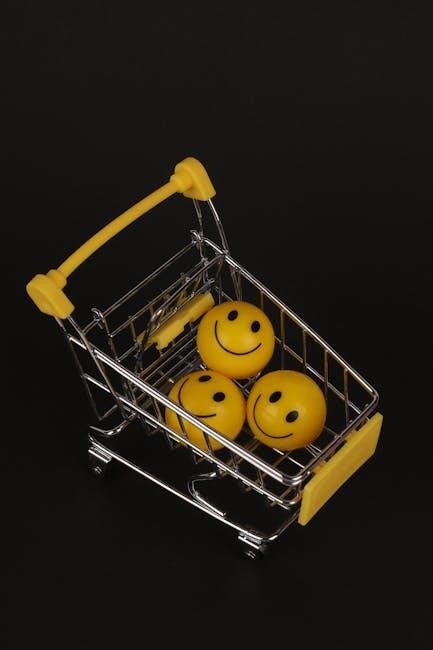
cartes émotions à imprimer pdf
Emotional cards are visual tools designed to help individuals identify and express feelings. They are widely used in therapy, education, and personal growth. Available as printable PDFs, these cards offer a convenient way to explore emotions, fostering self-awareness and communication. Their colorful designs and inclusive language make them accessible to diverse audiences.
1.1. Definition and Purpose of Emotional Cards
Emotional cards are visual tools designed to help individuals identify, express, and manage emotions. They typically feature words, images, or scenarios that evoke feelings, making them accessible for various audiences. Available as printable PDFs, these cards are widely used in therapy, education, and personal development. Their primary purpose is to enhance emotional awareness, improve communication, and foster self-reflection. By exploring emotions in a structured way, emotional cards empower users to better understand their feelings and develop healthier emotional responses. They are versatile, suitable for both personal use and group activities, making them a valuable resource for emotional growth and well-being.
1.2. Importance of Emotional Expression in Daily Life
Emotional expression is crucial for mental well-being, fostering healthy relationships, and personal growth. It allows individuals to communicate feelings effectively, reducing misunderstandings and stress. Expressing emotions also promotes self-awareness and empathy, essential for building strong connections with others. In a busy world, emotional expression helps maintain emotional balance and resilience. Tools like printable emotional cards provide a structured way to identify and articulate feelings, making emotional expression more accessible and meaningful in daily life.
Types of Emotional Cards Available for Printing
Emotional cards come in pre-designed PDFs, customizable templates, and colorful or black-and-white designs, offering versatile options for personal or professional use.
2.1. Pre-Designed Emotional Card PDFs
Pre-designed emotional card PDFs are ready-to-use templates that simplify the process of creating emotional cards. These PDFs often feature professionally crafted designs, making them ideal for quick printing. Many options, such as the popular 25 Emotional and Sensory Cards in Color, are available online. They include a variety of emotions and scenarios, catering to different audiences, including children and adults. These pre-designed cards save time and effort, offering a polished and visually appealing result. Some PDFs also allow minimal customization, such as adding personal messages, while others are fully editable. They are widely accessible on platforms like Etsy or Educ’Arts, ensuring easy downloading and printing for therapeutic or educational activities.

2.2. Customizable Emotional Card Templates
Customizable emotional card templates offer flexibility for users to tailor cards to specific needs. These templates allow editing of text, colors, and images, enabling personalization for various audiences. Popular tools like Canva or Adobe Illustrator facilitate easy customization. Users can adapt cards for children, adults, or therapeutic purposes, ensuring relevance and engagement. Customizable templates promote creativity and precision, making emotional expression more impactful. They are ideal for educators, therapists, and individuals seeking unique designs. With customizable options, emotional cards become more versatile, catering to diverse preferences and enhancing their effectiveness in fostering emotional intelligence and communication.
2.3. Colorful vs. Black and White Designs
Emotional cards are available in both colorful and black-and-white designs, each offering unique benefits. Colorful cards enhance visual appeal and can evoke stronger emotional responses, making them ideal for children or therapeutic settings. Black-and-white designs are simpler, cost-effective, and versatile for various activities. They also allow users to focus on the emotional content without visual distractions. Both options cater to different preferences and needs, ensuring flexibility in their use. Whether vibrant or monochromatic, the design choice depends on the intended audience and purpose, making emotional cards adaptable for diverse applications and personalization.
Uses of Emotional Cards
Emotional cards enhance emotional intelligence, improve communication, and encourage self-awareness. They are versatile tools for education, therapy, and personal growth, suitable for various settings.

3.1. Educational and Therapeutic Applications
Emotional cards are widely used in educational and therapeutic settings to help individuals identify and manage emotions. In schools, they assist students in recognizing feelings, fostering empathy, and creating a supportive environment. Therapists use these cards to guide patients in exploring emotional experiences, developing coping strategies, and improving mental health. The cards are particularly effective in therapy sessions, enabling individuals to articulate emotions they may struggle to express verbally. By leveraging visual and textual cues, emotional cards bridge communication gaps, making them invaluable tools for educators and mental health professionals. Their versatility ensures they can be adapted to various age groups and therapeutic needs.
3.2. Emotional Awareness and Self-Reflection
Emotional cards are powerful tools for fostering emotional awareness and self-reflection. By identifying and exploring emotions depicted on the cards, individuals can gain deeper insights into their feelings and thoughts. These cards encourage introspection, helping users recognize patterns and triggers associated with specific emotions. Self-reflection activities, such as journaling or meditation, can be enhanced by selecting cards that resonate with one’s current emotional state. This process empowers individuals to acknowledge, understand, and manage their emotions more effectively, promoting personal growth and emotional well-being. Regular use of emotional cards can cultivate mindfulness and a greater understanding of oneself.
3.3. Group Activities and Workshops
Emotional cards are excellent tools for group activities and workshops, fostering collaboration and emotional understanding. They can be used in icebreakers, team-building exercises, or role-playing scenarios to encourage open dialogue. Participants can share emotions, perspectives, and experiences, creating a safe space for connection. Workshops often incorporate card-based games or discussions to explore complex emotions, helping individuals develop empathy and interpersonal skills. These activities are particularly effective in educational, therapeutic, or corporate settings, promoting a deeper understanding of emotional dynamics within groups. Emotional cards also serve as a catalyst for creative problem-solving and conflict resolution, making them versatile for diverse workshop objectives.

Popular Emotional Card PDFs Available Online
Discover diverse emotional card PDFs online, catering to various needs and audiences. These include vibrant designs, universal themes, and customizable options, perfect for therapy, education, or personal use. Many sets offer instant downloads, making them easily accessible for workshops, classrooms, or home activities. They often feature colorful illustrations, inclusive language, and a wide range of emotions to suit different preferences and requirements.
4.1. 25 Emotional and Sensory Cards in Color
This vibrant set of 25 emotional and sensory cards is designed to evoke feelings and sensations. Each card features bold, colorful illustrations paired with emotion-related words or phrases. They are ideal for helping individuals identify, express, and explore their emotions. These cards are particularly popular in therapeutic and educational settings, as they cater to diverse age groups and needs. The sensory aspect encourages deeper engagement, making them suitable for activities that promote self-awareness and communication. Their high-quality design ensures they are visually appealing and durable when printed, making them a great tool for workshops, classrooms, or personal use.
4.2. 16 Emotional Cards for Children
The set of 16 emotional cards for children is specifically designed to help young minds identify and express their feelings. These colorful cards feature simple, age-appropriate language and relatable images, making them ideal for kids aged 4–12. They cover a range of emotions, from happiness and excitement to sadness and anger, encouraging open conversations about feelings. Teachers, parents, and therapists often use these cards in educational and therapeutic settings to foster emotional intelligence and healthy communication. Their vibrant design and clear expressions make them engaging tools for helping children navigate their emotional world effectively.

4.3. Emotional Card Sets with Inclusive Writing
Emotional card sets with inclusive writing are designed to represent diverse experiences and identities. These cards use non-binary pronouns and neutral language to ensure everyone feels represented. They include a wide range of emotions and situations, making them accessible to all individuals, regardless of gender, culture, or background. Inclusive writing fosters empathy and understanding, helping users from different walks of life connect with the emotions expressed. These sets are particularly popular in educational and therapeutic settings, as they promote acceptance and reduce stereotypes. By using inclusive language, these cards create a safe space for emotional exploration and growth.

How to Create Your Own Emotional Cards
Creating custom emotional cards involves selecting meaningful emotions, designing visuals, and adding prompts. Use tools like Canva or Adobe Illustrator for professional designs. Ensure high-quality printing for durability and clarity, making them perfect for personal or therapeutic use.
5.1; Design Tips for Emotional Card Creation
When designing emotional cards, prioritize clarity and readability. Use large, easy-to-read fonts and contrasting colors for accessibility. Incorporate relevant images or icons to visually represent emotions, enhancing understanding. Balance text and visuals to avoid clutter. Consider minimalistic designs for a professional look. Ensure cards are durable by using high-quality paper. For children, opt for brighter colors and playful visuals, while adults may prefer subdued tones. Tailor designs to your audience’s needs, ensuring emotional expressions are relatable and impactful. This approach creates effective tools for emotional expression and learning.
5.2. Tools for Designing Emotional Cards
Various tools are available for designing emotional cards, catering to different skill levels and preferences. Canva offers user-friendly templates and drag-and-drop features, ideal for beginners. Adobe Illustrator provides advanced design capabilities for professionals. Microsoft PowerPoint is another accessible option for creating card layouts. Online tools like Vectary enable 3D design elements. Additionally, free design software such as GIMP or Inkscape can be used for more artistic customization. Many websites also offer pre-designed emotional card templates in PDF format, saving time for those who prefer ready-to-print options. These tools ensure that emotional cards are both visually appealing and emotionally impactful.
5.3. Printing Tips for High-Quality Cards
For high-quality emotional cards, use sturdy cardstock with a minimum of 200-300 GSM for durability. Choose matte or glossy finishes based on the design. Ensure your printer settings are configured for high DPI to maintain crisp text and vibrant colors. Align the print settings with the paper type for optimal results; Test print a sample to verify colors and alignment before printing in bulk. Use a precise cutter or scissors for clean edges. Consider laminating the cards for longevity. Finally, use high-quality ink cartridges to ensure the colors and details are vivid and professional. These tips ensure your emotional cards look and feel exceptional.
Benefits of Using Emotional Cards
Emotional cards enhance self-awareness, communication, and empathy, fostering deeper connections. They aid in therapy, education, and personal growth, providing a visual tool for expressing feelings effectively.
6.1. Enhancing Emotional Intelligence
Emotional cards are powerful tools for enhancing emotional intelligence by helping individuals identify, understand, and manage their emotions. They provide visual cues that make complex feelings tangible, fostering self-awareness and empathy. By regularly engaging with these cards, users can improve their ability to recognize emotional patterns, leading to better decision-making and interpersonal relationships. This practice is particularly beneficial for children, teaching them to articulate their feelings, and for adults seeking to deepen their emotional literacy. The structured format of emotional cards ensures consistent growth in emotional intelligence, making them a valuable resource for personal and professional development.
6.2. Improving Communication Skills
Emotional cards are invaluable for improving communication skills by providing a visual and structured way to express feelings. They help individuals articulate emotions that might otherwise go unspoken, fostering clearer and more meaningful conversations. By using these cards, people can identify and communicate their emotional states accurately, reducing misunderstandings. This tool is particularly effective in group settings, encouraging active listening and empathy. Emotional cards also serve as a bridge for non-verbal or hesitant individuals, helping them convey their thoughts confidently. Regular use enhances verbal and non-verbal communication, promoting healthier relationships and collaboration in both personal and professional environments.
6.3. Reducing Stress and Anxiety
Emotional cards play a crucial role in reducing stress and anxiety by helping individuals identify and process their emotions. By acknowledging and expressing feelings, users can alleviate emotional overload, which often contributes to stress. These cards encourage mindfulness and grounding techniques, allowing individuals to focus on the present moment. Regular use fosters self-awareness, enabling people to address triggers before they escalate. Additionally, emotional cards provide a healthy outlet for pent-up emotions, promoting relaxation and emotional balance. Their practical application makes them an accessible tool for managing stress and anxiety in daily life, contributing to overall mental well-being.

Emotional Card Activities for Different Audiences
Emotional card activities cater to diverse groups, offering tailored exercises that suit children, teenagers, adults, and professionals. These activities promote emotional exploration, collaboration, and personal growth.
7.1. Activities for Children and Teenagers
Emotional cards are a powerful tool for children and teenagers to explore their feelings. Activities include matching games, storytelling, and group discussions. For younger kids, sorting emotions by color or intensity helps develop recognition. Teenagers benefit from reflective exercises like writing emotional journals or creating art inspired by the cards. These activities foster empathy, self-awareness, and healthy communication skills. Teachers and parents can use pre-designed PDFs to create engaging workshops, ensuring a safe space for emotional expression and growth. Such practices not only enhance emotional intelligence but also build stronger interpersonal connections among participants.
7.2. Workshops for Adults and Professionals
Emotional cards are increasingly used in workshops for adults and professionals to enhance emotional intelligence and communication. These sessions often involve group activities like card-based discussions, role-playing, and reflective exercises. Professionals can explore complex emotions, develop empathy, and improve interpersonal skills. Workshops may focus on stress management, conflict resolution, and leadership development. Printable emotional card PDFs provide a practical tool for facilitators to create structured yet engaging experiences. Participants gain insights into emotional patterns, fostering a culture of understanding and collaboration in both personal and professional environments, ultimately leading to improved workplace dynamics and individual well-being.
7.3. Emotional Card Games for Families
Emotional card games offer a fun and interactive way for families to connect and understand each other’s feelings. Activities like “Feelings Charades” or “Emotion Storytelling” encourage open communication and empathy. Families can use printable emotional card PDFs to create games that help children identify and express emotions. These games foster a supportive environment, teaching kids to recognize and articulate their feelings while strengthening family bonds. They also provide a creative outlet for adults to engage with their children on a deeper level, promoting emotional intelligence and understanding within the household.

Where to Find Emotional Card PDFs

Emotional card PDFs are readily available online through platforms like Etsy, Teachers Pay Teachers, and specialized emotional wellness websites, offering both free and premium options for easy printing.
8.1. Free Emotional Card PDFs Online
Free emotional card PDFs can be found on platforms like Etsy, Teachers Pay Teachers, and Pinterest, offering a variety of designs for personal or educational use. Websites such as Canva and Google Drive also provide downloadable templates. These resources are ideal for those seeking cost-effective solutions to create emotional cards. Many designs are customizable, allowing users to tailor cards to specific needs. While some free options may be limited in design complexity, they remain a practical choice for individuals and educators looking to explore emotional expression without additional costs. Always ensure to verify licensing terms for personal or commercial use.
8.2. Paid Emotional Card Sets with Additional Features
Paid emotional card sets offer enhanced features such as customizable designs, high-resolution graphics, and exclusive content. Platforms like Etsy and Creative Market provide premium options with editable templates, allowing users to personalize cards for specific needs. These sets often include additional resources, such as activity guides or digital versions, making them ideal for professionals and educators. Paid cards may also feature unique artwork or specialized themes, such as mindfulness or sensory-focused designs. While free options are available, paid sets deliver higher quality and versatility, making them a worthwhile investment for those seeking advanced tools for emotional expression and education.
8.3. Websites Specializing in Emotional Card Downloads
Several websites specialize in offering high-quality emotional card PDFs for printing. Platforms like Etsy, Teachers Pay Teachers, and Canva provide a wide range of emotional card designs, from pre-designed templates to customizable options. These websites often cater to educators, therapists, and individuals seeking tools for emotional expression. Many offer exclusive designs, including themed sets for children, adults, or specific emotional focuses. Some sites also provide bundles with activity guides or digital versions for added convenience. These resources are ideal for those looking for professional-grade materials to support emotional growth and awareness in various settings.

Psychological Impact of Emotional Cards
Emotional cards positively influence mental well-being by enhancing emotional intelligence, fostering mindfulness, and reducing stress. They provide a healthy outlet for expressing and managing emotions effectively.
9.1. The Role of Emotions in Physical Health
Emotions significantly influence physical health, as unmanaged stress and anxiety can lead to chronic conditions like hypertension and weakened immunity. Emotional cards help individuals identify and process emotions, reducing cortisol levels and promoting relaxation. By fostering emotional awareness, they encourage healthier coping mechanisms, which can improve heart health, digestion, and overall well-being. Regular use of emotional cards contributes to a balanced mental and physical state, enhancing resilience against illness and supporting long-term health outcomes.
9.2. How Emotional Cards Foster Mindfulness
Emotional cards are powerful tools for fostering mindfulness by encouraging individuals to pause, reflect, and connect with their feelings. By identifying and labeling emotions, users cultivate present-moment awareness, a core aspect of mindfulness. These cards help individuals recognize emotional patterns, promoting self-reflection and acceptance. Regular use enhances emotional balance and reduces reactivity, fostering a non-judgmental space for emotional exploration. This mindful engagement with emotions supports mental clarity and inner peace, making emotional cards a valuable resource for mindfulness practices in both personal and therapeutic settings.
9.3. Case Studies on Emotional Card Effectiveness
Case studies highlight the effectiveness of emotional cards in fostering emotional awareness and well-being. In educational settings, students using emotional cards showed improved emotional recognition and expression, leading to better social interactions. In therapeutic contexts, patients reported enhanced emotional regulation and stress reduction after incorporating emotional cards into their routines. One study found a 30% improvement in emotional intelligence among participants who used emotional cards regularly. These real-world applications demonstrate the practical benefits of emotional cards in promoting mental health and emotional balance across diverse populations.
Emotional cards are increasingly valued for their role in mental health and education. Advances in design and technology promise expanded accessibility and innovation, ensuring their continued relevance.
10.1. The Growing Popularity of Emotional Cards
Emotional cards, particularly in printable PDF formats, have gained significant traction due to their accessibility and versatility. Their popularity stems from the growing emphasis on mental health and emotional well-being. Educators, therapists, and individuals increasingly use these cards to facilitate emotional expression and awareness. The convenience of digital access allows users todownload and print high-quality designs, making them a practical tool for workshops, classrooms, and personal use. Additionally, the diversity of designs and themes caters to various audiences, fostering a sense of connection and shared understanding. As awareness of emotional intelligence grows, so does the demand for these meaningful resources.
10.2. Innovations in Emotional Card Design
Innovations in emotional card design have revolutionized their appeal and functionality. Modern printable PDFs now incorporate interactive elements like augmented reality (AR) features, allowing users to explore emotions in 3D. AI-generated designs enable personalized card creation, tailoring visuals and phrases to individual needs. Inclusive language and diverse representations ensure accessibility for all cultures and identities. Digital annotation tools allow users to customize cards post-printing, enhancing engagement. These advancements make emotional cards more dynamic and adaptable, catering to a wide range of audiences and applications. Such innovations ensure emotional cards remain a cutting-edge tool for emotional well-being and education.
10.3. The Role of Technology in Emotional Card Development
Technology has significantly advanced the development of emotional cards, offering innovative ways to create and share them. Digital design tools enable the production of high-quality, customizable PDFs, while AI algorithms suggest relevant emotions and designs based on user needs. Interactive features, such as QR codes linking to audio or video explanations, enhance engagement. Mobile apps now allow users to create and print emotional cards directly from their devices. Additionally, technology facilitates global accessibility, enabling instant downloads and translations into multiple languages. These advancements ensure emotional cards remain relevant and adaptable to diverse cultural and personal requirements.